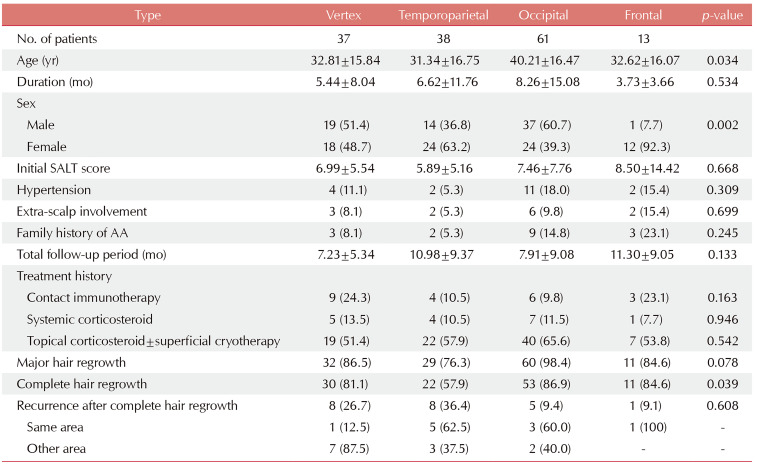Topographical Difference in the Prognosis of Alopecia Areata.
IF 1.5
4区 医学
Q3 DERMATOLOGY
引用次数: 0
Abstract
Dear Editor: Although macroscopic clinical parameters such as disease duration, extra-scalp hair loss, and extent of hair loss can be used as prognostic markers for alopecia areata (AA), these factors have limitations in directly explaining the localized shortterm course of individual alopecia patches. The inf luence of regional factors on the course of AA is unclear due to the randomness of occurrence and chronic relapsing course. This study aimed to evaluate the clinical characteristics and prognosis of AA according to the area affected. This retrospective analysis included patients with AA who visited Wonju Severance Christian Hospital from March 2013 to February 2020. Among patients, individuals with alopecia patches were analyzed using Olsen/Canfield SALT (Severity of Alopecia Tool) score. Olsen/Canfield SALT was divided into top, posterior, and lateral areas, so we arbitrarily divided it into four areas (frontal, temporoparietal, vertex, and occipital) to determine the correlation with the anatomical location region in more detail. Involving only one of the four areas within the scalp were included in the analysis. The patients were divided into four groups according to the affected area. Demographic data including age, sex, disease duration, initial extent of hair loss, and presence of extra-scalp hair loss were compared between groups. The prognosis and recurrence between groups were analyzed using the Kaplan-Meier method. This study was approved by the institutional review board of Wonju Severance Christian Hospital (CR317095). A waiver of informed consent was granted owing to the deidentified data used. No clinical variables, except age and sex, were significantly different between groups (Table 1). On cumulative incidence analysis, there was significant difference between groups with regard to complete hair regrowth (>90% hair regrowth compared to initial extent) unlike major hair regrowth (>60% hair regrowth compared to initial extent) (Fig. 1). In particular, the difference in prognosis between groups was found to be more noticeable with long-term treatment. Although the recurrence rate was the highest in the temporoparietal group, there was no difference between groups in the survival analysis of hair loss after achieving hair regrowth (Supplementary Fig. 1). Differences in the anatomical structure, vascularity, and innervation are involved in topographical differences of AA. Recently, based on the relationship between mechanical stress and autoimmunity in the skin or other organs, it has been speculated that site-specific activation of mechanical stress may induce regional differences in autoimmunity. Differences in mechanical properties according to the scalp regions have been experimentally proven, extending beyond numerical differences in terminal hair or hair follicle units. These differences would provide another clue in explaining topographic differences in AA. However, it is unclear whether these stresses or differences in intrinsic properties lead to selective dysregulation of immunity around hair follicles. The study has few disadvantages. It is a single institutional study including a small number of samples of only mild-tomoderate AA cases involving only one of the four areas within Brief Report Annals of Dermatology 2023;35(3) • https://doi.org/10.5021/ad.20.329


斑秃预后的地形差异。
本文章由计算机程序翻译,如有差异,请以英文原文为准。
求助全文
约1分钟内获得全文
求助全文
来源期刊

Annals of Dermatology
医学-皮肤病学
CiteScore
1.60
自引率
6.20%
发文量
77
审稿时长
6-12 weeks
期刊介绍:
Annals of Dermatology (Ann Dermatol) is the official peer-reviewed publication of the Korean Dermatological Association and the Korean Society for Investigative Dermatology. Since 1989, Ann Dermatol has contributed as a platform for communicating the latest research outcome and recent trend of dermatology in Korea and all over the world.
Ann Dermatol seeks for ameliorated understanding of skin and skin-related disease for clinicians and researchers. Ann Dermatol deals with diverse skin-related topics from laboratory investigations to clinical outcomes and invites review articles, original articles, case reports, brief reports and items of correspondence. Ann Dermatol is interested in contributions from all countries in which good and advanced research is carried out. Ann Dermatol willingly recruits well-organized and significant manuscripts with proper scope throughout the world.
 求助内容:
求助内容: 应助结果提醒方式:
应助结果提醒方式:


